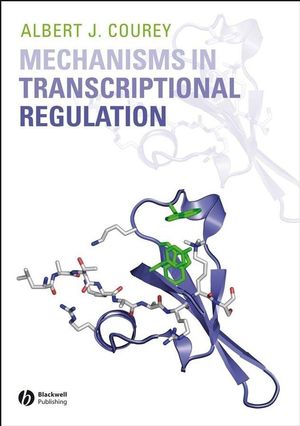Mechanisms in Transcriptional RegulationISBN: 978-1-4051-0370-1
Paperback
248 pages
April 2008, Wiley-Blackwell
 |
||||||
Preface.
Acknowledgments.
1 The vocabulary of transcription.
1.1 Introduction 1.
1.2 The vocabulary of transcription.
1.2.1 RNA biogenesis.
1.2.2 The transcriptional machinery.
1.2.3 Cis-elements.
1.3 Evolutionarily conserved mechanisms of transcription.
1.3.1 Conservation across the three domains of life.
1.3.2 Model eukaryotic organisms (and a plug for genetics).
1.4 What’s coming up.
Problems.
Further reading.
2 RNA polymerases and the transcription cycle.
2.1 Introduction.
2.2 Core RNA polymerases.
2.2.1 Bacterial core polymerases.
2.2.2 Eukaryotic and archaeal core polymerases.
2.3 Transcriptional elongation.
2.3.1 Phosphoester linkage formation.
2.3.2 Features of the ternary elongation complex.
2.3.3 RNA polymerase as a motor.
2.3.4 Elongation factors and backtracking.
2.4 Transcriptional initiation.
2.4.1 Distinct mechanisms for promoter recognition in bacteria and eukaryotes.
2.4.2 Bacterial σ factors and promoter specificity.
2.5 Transcriptional termination.
2.5.1 Why terminate?.
2.5.2 Termination in bacteria.
2.5.3 Termination in eukaryotes.
2.6 Summary.
Problems.
Further reading.
3 The eukaryotic basal machinery.
3.1 Introduction.
3.2 The class II core promoter.
3.3 The catalog of factors.
3.4 Pathway to the preinitiation complex.
3.5 Promoter recognition and nucleation of the PIC by TFIID.
3.5.1 TATA box recognition by TBP.
3.5.2 TBP-associated factors and their function in TFIID.
3.6 TFIIB: a functional analog of bacterial σ factors.
3.6.1 TFIIB as a bridge between the promoter and polymerase.
3.6.2 BRF, a TFIIB paralog in the class III machinery,and promoter melting.
3.6.3 Functional similarity between TFIIB family proteins and σ.
3.7 TFIIH in promoter opening and promoter clearance.
3.7.1 A unique DNA helicase requirement for class II promoter opening.
3.7.2 A connection between DNA repair and transcription.
3.7.3 TFIIH and RNA polymerase II phosphorylation.
3.8 Summary.
Problems.
Further reading.
4 Mechanisms of transcriptional activation.
4.1 Introduction.
4.2 Paradigms from E. coli.
4.2.1 CRP: a sensor of the nutritional environment.
4.2.2 λcI: regulator of the lysis/lysogeny switch.
4.2.3 Sequence-specific DNA recognition: the helix-turn-helix motif.
4.2.4 Dimerization.
4.2.5 Multiple targets for activators in the transcriptional machinery.
4.2.6 How do activator–RNA polymerase contacts activate promoters?.
4.3 Eukaryotic activators and their targets.
4.3.1 The modular nature of eukaryotic activators.
4.3.2 The Mediator: a special activator target in the eukaryotic transcriptional machinery.
4.3.3 Release of Pol II from a paused state as a mechanism of activation.
4.4 Summary.
Problems.
Further reading.
5 Transcriptional control through the modification of chromatin structure.
5.1 Introduction.
5.2 Chromatin structure.
5.2.1 The nucleosome.
5.2.2 Higher order chromatin structure.
5.2.3 Euchromatin and heterochromatin.
5.3 Histone modification.
5.3.1 Lysine acetylation: diverse roles in gene activation.
5.3.2 Lysine methylation: a chemically stable histone mark.
5.3.3 Cross talk between histone marks.
5.4 ATP-dependent chromatin remodeling enzymes.
5.4.1 A diverse family of chromatin remodeling complexes.
5.4.2 ATP-fueled motors for increasing DNA accessibility.
5.4.3 Targeting of chromatin remodeling complexes.
5.5 Protein motifs that recognize modified histones.
5.5.1 Chromodomains.
5.5.2 Bromodomains.
5.6 Coordination of activator–coactivator interactions.
5.7 Summary.
Problems.
Further reading.
6 Epigenetic control of transcription.
6.1 Introduction.
6.1.1 Common themes in epigenetics: a central role for histone methylation.
6.2 Heterochromatic silencing.
6.2.1 Chromosomal inheritance of the silent state.
6.2.2 Histone methylation and maintenance of the silent state.
6.2.3 Initiation of heterochromatic silencing.
6.2.4 Evolutionary conservation of mechanisms for heterochromatic silencing.
6.2.5 DNA methylation and heterochromatin.
6.2.6 A distinct mechanism for heterochromatic silencing in budding yeast.
6.3 Epigenetic control by Polycomb and Trithorax group proteins.
6.3.1 Combinatorial control of segment identity.
6.3.2 Establishment and maintenance phases of homeotic gene expression.
6.3.3 Parallels between heterochromatic and PcG silencing.
6.3.4 Maintenance of the active state by TrxG.
6.3.5 A model for the epigenetic regulation of homeoticgene activity.
6.4 X chromosome inactivation: parallels to heterochromatic and Polycomb group silencing.
6.4.1 Random inactivation of the X chromosome.
6.4.2 Cis-acting RNA in X inactivation.
6.4.3 Histone modifications characteristic of both heterochromatic and PcG silencing on Xi.
6.5 Summary.
Problems.
Further reading.
7 Combinatorial control in development and signal transduction.
7.1 Introduction.
7.2 Synergy and antagonism.
7.2.1 Integration of regulatory inputs by cis-regulatory modules.
7.2.2 The “AND” and “NOT” operators.
7.3 Synergy and the enhanceosome.
7.3.1 Enhanceosome assembly and architectural factors.
7.3.2 Cooperative recruitment of coactivators by enhanceosomes.
7.3.3 Sequential coactivator recruitment.
7.4 Antagonism and stripe formation.
7.4.1 Developmental regulatory networks.
7.4.2 Short-range repression and stripe formation.
7.5 Antagonism and the signal-mediated switch.
7.5.1 Nuclear receptors: antagonism between coregulators.
7.5.2 Receptor tyrosine kinase pathways: competition for a common DNA element.
7.6 Summary.
Problems.
Further reading.
Answers to problems.
Glossary.
Index.
Color plate section



